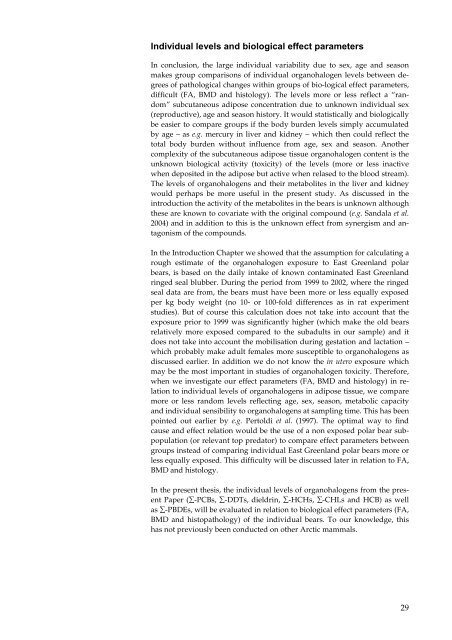Organohalogen concentrations and a gross and histologic ...
Organohalogen concentrations and a gross and histologic ...
Organohalogen concentrations and a gross and histologic ...
You also want an ePaper? Increase the reach of your titles
YUMPU automatically turns print PDFs into web optimized ePapers that Google loves.
Individual levels <strong>and</strong> biological effect parameters<br />
In conclusion, the large individual variability due to sex, age <strong>and</strong> season<br />
makes group comparisons of individual organohalogen levels between degrees<br />
of pathological changes within groups of bio-logical effect parameters,<br />
difficult (FA, BMD <strong>and</strong> histology). The levels more or less reflect a “r<strong>and</strong>om”<br />
subcutaneous adipose concentration due to unknown individual sex<br />
(reproductive), age <strong>and</strong> season history. It would statistically <strong>and</strong> biologically<br />
be easier to compare groups if the body burden levels simply accumulated<br />
by age – as e.g. mercury in liver <strong>and</strong> kidney – which then could reflect the<br />
total body burden without influence from age, sex <strong>and</strong> season. Another<br />
complexity of the subcutaneous adipose tissue organohalogen content is the<br />
unknown biological activity (toxicity) of the levels (more or less inactive<br />
when deposited in the adipose but active when relased to the blood stream).<br />
The levels of organohalogens <strong>and</strong> their metabolites in the liver <strong>and</strong> kidney<br />
would perhaps be more useful in the present study. As discussed in the<br />
introduction the activity of the metabolites in the bears is unknown although<br />
these are known to covariate with the original compound (e.g. S<strong>and</strong>ala et al.<br />
2004) <strong>and</strong> in addition to this is the unknown effect from synergism <strong>and</strong> antagonism<br />
of the compounds.<br />
In the Introduction Chapter we showed that the assumption for calculating a<br />
rough estimate of the organohalogen exposure to East Greenl<strong>and</strong> polar<br />
bears, is based on the daily intake of known contaminated East Greenl<strong>and</strong><br />
ringed seal blubber. During the period from 1999 to 2002, where the ringed<br />
seal data are from, the bears must have been more or less equally exposed<br />
per kg body weight (no 10- or 100-fold differences as in rat experiment<br />
studies). But of course this calculation does not take into account that the<br />
exposure prior to 1999 was significantly higher (which make the old bears<br />
relatively more exposed compared to the subadults in our sample) <strong>and</strong> it<br />
does not take into account the mobilisation during gestation <strong>and</strong> lactation –<br />
which probably make adult females more susceptible to organohalogens as<br />
discussed earlier. In addition we do not know the in utero exposure which<br />
may be the most important in studies of organohalogen toxicity. Therefore,<br />
when we investigate our effect parameters (FA, BMD <strong>and</strong> histology) in relation<br />
to individual levels of organohalogens in adipose tissue, we compare<br />
more or less r<strong>and</strong>om levels reflecting age, sex, season, metabolic capacity<br />
<strong>and</strong> individual sensibility to organohalogens at sampling time. This has been<br />
pointed out earlier by e.g. Pertoldi et al. (1997). The optimal way to find<br />
cause <strong>and</strong> effect relation would be the use of a non exposed polar bear subpopulation<br />
(or relevant top predator) to compare effect parameters between<br />
groups instead of comparing individual East Greenl<strong>and</strong> polar bears more or<br />
less equally exposed. This difficulty will be discussed later in relation to FA,<br />
BMD <strong>and</strong> histology.<br />
In the present thesis, the individual levels of organohalogens from the present<br />
Paper (∑-PCBs, ∑-DDTs, dieldrin, ∑-HCHs, ∑-CHLs <strong>and</strong> HCB) as well<br />
as ∑-PBDEs, will be evaluated in relation to biological effect parameters (FA,<br />
BMD <strong>and</strong> histopathology) of the individual bears. To our knowledge, this<br />
has not previously been conducted on other Arctic mammals.<br />
29

















